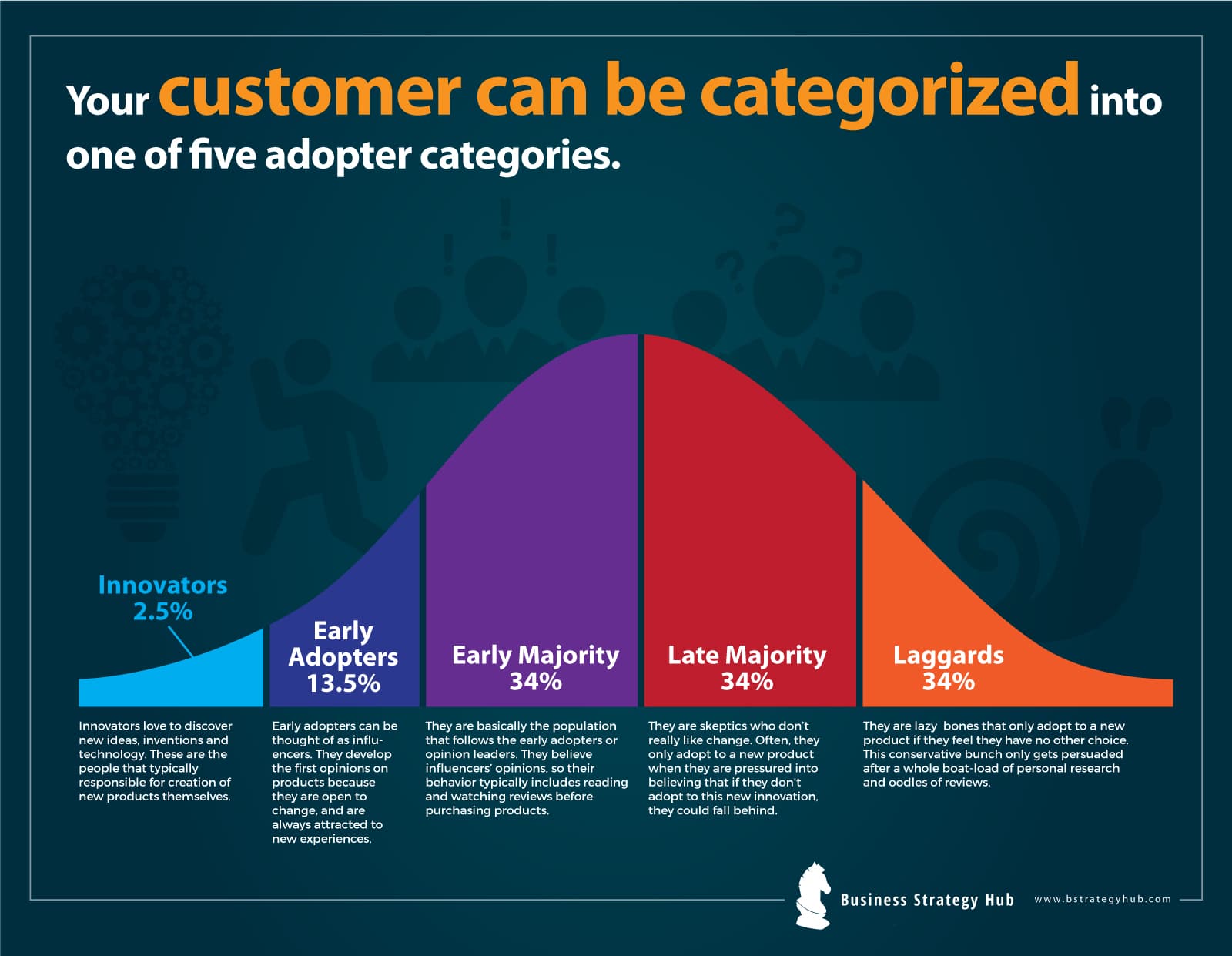Model Name : Diffusion of Innovation Theory
Creator : E.M. Rogers
Year : 1962
Purpose : Product momentum gain | new product launch | social communication and product adoption studies | devising targeted marketing strategies | Improved product innovation | Product innovation testing | Market observation | Influencing customers’ decision-making process.
Got a new product launch underway?
That’s a scary business. It could become an enormous sensation overnight like Pokémon Go, or it could sink, like the Apple Watch.

I mean, if an Apple product can fail, then how many of us are safe? But before we get into that, answer a question first:
Where do new products come from?
They’re not developed by mad scientists in their basement laboratories on a whim.
They’re not developed by lone geniuses who can turn a sudden burst of inspiration into full-fledged practical innovation.
In reality, product innovation is a lot more complicated. Talent and inspiration are important, yes, but not important enough to carry you all the way.
As the years go by, product innovation becomes harder and harder.
This is because it is now that much harder to get customers to accept and adapt to your product.
If you want to create and launch a successful product today, you’ll need a whole team by your side, made up of:
• Product Engineers
• Sales representatives
• Marketing experts and digital marketing mavens
• Financial experts
• Manufacturing authorities
• Lawyers
And you will need a theory…
At the heart of every product innovation is one goal – to bring to life a new way to solve the customers’ problems – a new solution that blows all the previous products out of the water.
To prove to your customers that your new product is the ultimate solution to their problems, you absolutely must understand your customer base first. Also, you must understand your customer maturity.
After all, we live in the age of the customer. It’s all about the customers’ needs, opinions, voices, and changing needs.
It takes into consideration other factors as well. Newer product innovations are not successful unless they are adopting different customer needs.
Luckily, all this can be simply understood thanks to a simple theory.
The Diffusion of Innovation theory. This ingenious early social science theory is the key to understanding how a product can gain momentum over time.
The diffusion theory explains that some people will adopt to your new product faster than others. The rate at which different people adapt to your product depends on their different socio-psychological characteristics and attributes.
This theory will help you ensure that your new product grows in use and popularity amongst the target population.
The better you understand the different kinds of customers you are introducing your product to, the more efficient and successful your overall marketing and digital marketing efforts will be.
What do your adopters look like?

According to the diffusion of innovation theory, every customer can be categorized into one of five adopter categories.
For every category, your digital marketing and product placement strategies should be different. Go through the five definitions to understand where the majority of your target audience falls.
This is how you figure out their key adoption motivators. This is how you learn to market your new product to them in such a way that they just can’t refuse.
1. Innovators
Innovators love to discover new ideas, inventions, and technology. These are the people that typically responsible for the creation of new products themselves.
Pro Tip: To target Innovators, you should promote your product on popular relevant websites and purchase outlets. Display promotional digital marketing collateral to give the impression that your product has already been adopted by the market’s key stakeholders.
2. Early Adopters
Early adopters can be thought of as influencers. They develop the first opinions on products because they are open to change, and are always attracted to new experiences. These people like to leave positive testimonials for products they like, as well as negative feedback when they think a new product is not up to the mark.
Pro Tip: Early Adopters can be won over using case studies where like-minded customers are describing positive experiences with the new product. Early adopters don’t want to feel like they are the ones conducting preliminary trials of the product. They want to feel like people have started finding this product successful and influencers are using it happily.
3. Early Majority
The early majority is the population that follows the early adopters or opinion leaders. They believe influencers’ opinions, so their behavior typically includes reading and watching reviews before purchasing products.
Pro Tip: ‘How to’ videos, blog posts and reviews describing the product and the positive experiences it provides, are what will get the early majority hooked.
4. Late Majority
The late majority is made up of skeptics who don’t really like change. Often, they only adopt a new product when they are pressured into believing that if they don’t adopt this innovation, they could fall behind.
Pro Tip: As long as the people in the late majority category are consistently exposed to product placements and reviews on the various social media and retail platforms, they will soon start feeling like they have to jump on board before they miss the train.
5. Laggards
These lazy bones will only adopt a new product if they feel they have no other choice. This conservative bunch only gets persuaded after a whole boat-load of personal research and oodles of reviews. Sometimes, they succumb to social pressure, too.
Pro Tip: When it comes to laggards, it’s a better idea to focus on targeting customers in the other adoption categories. When the product launch process runs its course, the laggards will eventually come on board themselves.
The law of diffusion of innovation illuminates the process of how people ultimately adopt a new product on the market.
Final Thoughts
REMEMBER:
Customers adopting your new product would have to experience a point of change and start purchasing and using your product instead of the one they were used to before.
That’s a pretty big deal, don’t you think?
That’s why it doesn’t usually happen overnight, nor does it happen simultaneously among the entire targeted population.
By following customers’ social behavior theories as outlined by the law of diffusion of innovation, you can guarantee the success of your product by using marketing strategies conceptualized with unparalleled confidence.
References & more information
www.consumerpsychologist.com












Add comment